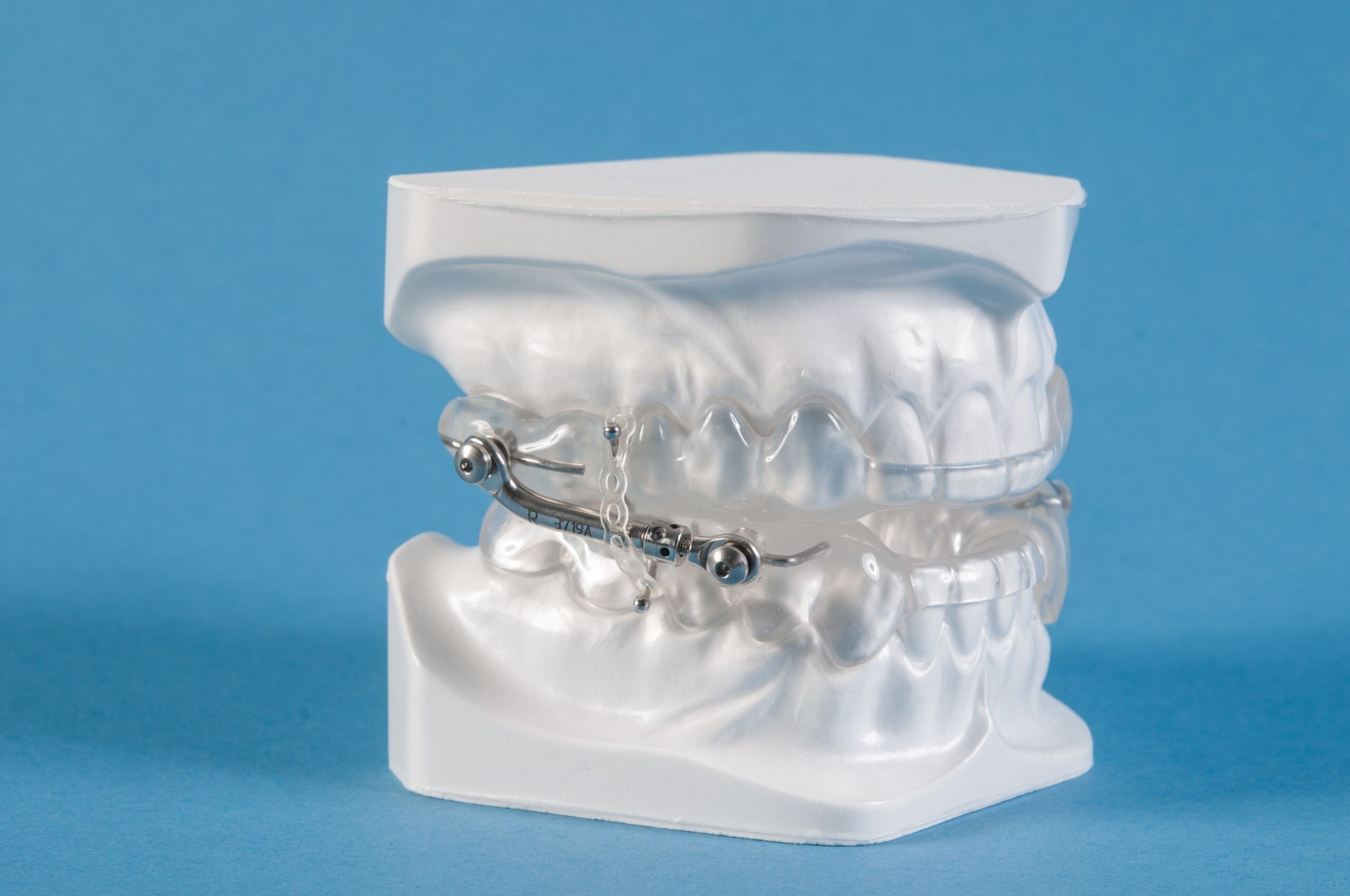Overview
The diagnosis of OSAS is confirmed in the sleep laboratory and the severity is recorded.
Propofol sleep endoscopy is used to visualize the exact location of the collapse.
The gold standard, nocturnal positive pressure ventilation via a mask (CPAP therapy) is not tolerated by all patients.
The mandibular advancement splint is used as an alternative treatment option.
By advancing the lower jaw as a result of the splint, the airways are widened, thus reducing the risk of collapse.
At the Clinic for Oral and Maxillofacial Surgery at the USZ, mandibular advancement splints are produced in a digital workflow.
This eliminates the need for jaw impressions with conventional impression materials, which are often perceived as unpleasant.
In addition to the protrusion splint, the Clinic for Oral and Maxillofacial Surgery offers an efficient surgical technique for the treatment of obstructive sleep apnoea syndrome.
This involves the surgical advancement of the upper and lower jaw with widening of the upper airways.
It is a one-off procedure with a permanent effect.
After successful advancement of the upper and lower jaw, CPAP therapy or a protrusion splint can be dispensed with.
This so-called repositioning osteotomy has been performed successfully for decades and leaves no visible scars on the face.
Thanks to the use of digital technology, the procedure can be planned precisely and performed safely in the operating room.
The computer-aided simulation of the future facial profile facilitates the preliminary discussion and joint decision-making process with our patients.
Patients suffering from obstructive sleep apnoea syndrome are advised on an interdisciplinary basis by maxillofacial surgeons, colleagues from the ORL and the sleep laboratory at the University Hospital Zurich.
Frequently asked questions
Why is treatment important for OSAS?
The airway obstruction leads to a wake-up reaction and non-restorative sleep.
The main symptom is excessive daytime sleepiness with attacks of falling asleep, which make it impossible to drive.
Reduced performance with states of fatigue lead to a reduced quality of life, even preventing the patient from working, as well as a disturbed libido.
The nocturnal waking phases (“arousals”) cause a physical stress situation, which leads to strain on the cardiovascular system.
The serious consequences can be a stroke or heart attack.
Does all snoring need to be treated?
No, not all snoring leads to airway obstruction.
In cases without obstructive symptoms, there is no general health risk.
When is a mandibular advancement splint indicated?
The protrusion splint is used for patients who suffer from a mild to moderate form of OSAS and cannot tolerate CPAP treatment.
New studies also show a positive effect in the short to medium term for severe forms of OSAS.
How does the protrusion splint work?
By advancing the lower jaw, the upper airways are widened, the base of the tongue is pulled forward, together with the epiglottis, and the risk of obstruction of the upper airways during sleep is significantly reduced.
What side effects can the protrusion splint have?
The decoupling of the chewing surfaces can lead to undesirable tooth movements.
Likewise, masticatory complaints such as jaw and muscle pain are described.
These side effects can be detected and avoided at an early stage by customizing the splint and carrying out regular follow-up checks.
How do you use the mandibular advancement splint?
The splint is worn at night.
Splint care is simple and ideal cleaning consists of daily hygiene with a toothbrush and washing-up liquid.
Toothpaste should not be used, as the abrasive substances it contains make the plastic porous.
Professional check-ups should be carried out every six months.

Protrusion splint with advancement of the lower jaw and consecutive widening of the upper airway.
The advancement can be individually and therefore optimally adjusted.
When is surgical advancement of the upper and lower jaw indicated?
The procedure is used in patients who suffer from a mild to moderate form of OSAS and cannot tolerate either CPAP treatment or protrusion splint therapy.
New studies show a positive effect with a cure rate of up to 100% of cases.
The repositioning osteotomy has a permanent effect and replaces the first two treatment options.
How is a conversion osteotomy performed?
The airways are widened through targeted advancement of the tooth-bearing jawbone.
The operation is planned digitally.
The necessary extent of movement is thus precisely defined and can be transferred to the operating theater.
Patient-specific plates are used at the USZ to reliably encode the result.
What side effects can surgical advancement have?
As with protrusion splint therapy, surgical advancement can trigger functional chewing disorders in individual cases.
Digital planning, surgical experience and close follow-up care can prevent functional disorders and permanent loss of sensation in the lower lip as well as injuries to the teeth.

Who bears the costs for a protrusion splint and jaw advancement?
The costs are generally covered by compulsory health insurance if the indication is correct and obstructive sleep apnoea syndrome is proven by sleep medicine.
To ensure that the costs are covered, an application for cost approval is submitted to the compulsory health insurance company before the splints are made and, of course, before surgical jaw repositioning.


